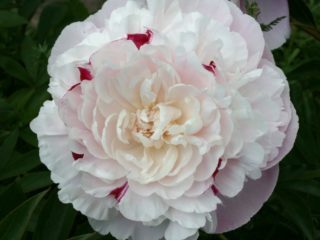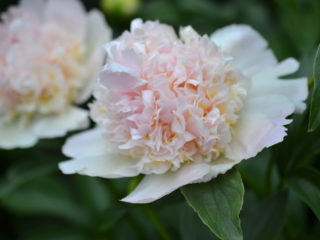Content
Peonies have long been the main decoration of the flower garden. This type of angiosperm is unpretentious in planting. But there are times when a peony grows poorly and does not bloom for several seasons. The reason for this may be improper care procedures, diseases, or soil composition. It is important to correctly determine the cause and prescribe treatment so that the problem is not transmitted to neighboring plants.

There are many reasons that contribute to stunting of growth.
Gardeners regularly introduce new varieties of angiosperms into their flower gardens. Peonies occupy a special place in this collection. Their species composition is varied, so colors and flavors can be chosen to suit every taste. These representatives of the flora are classified as resistant breeds; they tolerate the effects of cold, drought and disease without consequences. Sometimes inexperienced summer residents have a difficulty - the peony grows poorly. The cause of the disease is unclear, and proven remedies do not help. In this matter, it is necessary to conduct a comprehensive study of growing conditions, proximity to other plants, and the quality of fertilizers. Only after collecting all the necessary information can you begin treatment.
Why do peonies grow poorly?

Even with proper care of the bush, problems can arise
A plant may begin to grow poorly at one point, even if this variety has good fertility. There are many reasons that contribute to growth stagnation. It is important for novice gardeners to study all the nuances of planting so that in the future they do not encounter the difficulties of a lack of buds.
Nitrogen deficiency

Nitrogen is the main substance of fertile soil
The chemical element promotes the formation of proteins and nucleic acids, which affect growth. The amount of chlorophyll in the leaves, the main component of the photosynthesis process, also increases. Nitrogen forms the humus layer of the soil. Without it, fertile properties are impossible.
But too much nitrogen is also harmful. The chemical in large quantities causes frequent illnesses. This is all due to the lack of other nutrients; their supply is hampered by nitrogen. That is why gardeners should be careful about the doses of fertilizers applied. It is necessary to follow a feeding schedule depending on the season, temperature and condition of the crop.
Incorrect planting depth
Peonies have a branched rhizome, which increases in size every year. This indicator should be taken into account when choosing a landing height. If you dig a hole that is too small, the modified shoot will spread above the ground and, accordingly, will grow poorly. For the same reason, you need to retreat some distance from neighboring specimens. The rhizome grows very quickly and massively, so you should not expect strong branching. If a problem is discovered, you should immediately dig up the peony and make the recess lower and wider.

The planting hole should not be too deep
The buried space allows for excellent growth, but flowering does not occur. This agrotechnical solution is well suited for new plants during the adaptation period.
Diseases and pests
Compared to other representatives of angiosperms, peonies are distinguished by their resistance to diseases and insects. But there are often cases of diseases that were transmitted from neighboring seedlings, soil or other means. The most common diseases include: rust, gray rot, leaf spot, powdery mildew, etc. The main causative agents of the problems are insects and fungi.

An example of brown spot
Ants and aphids are the most common pests of flowers. They not only slow down the growth of plants, but also spoil the appearance. Ants are attracted to the sweet juice contained in peony petals. This is why beautiful buds are often spoiled. Well, aphids, which can be carried by ants, eat the entire tops, from the stem to the leaves. Because of this problem, the tree peony does not grow for a long time.
It is worthwhile to correctly apply the product to the care of peonies so as not to injure the seedling.
Unsuitable soil
If the peony does not grow well, there may be problems with the soil. Peat soils are not suitable for the plant. The normal flow of fluid in them is disrupted. The moisture either stagnates or quickly evaporates. And for high-quality growth of peonies, normal water balance is important.
The most suitable soils for the flora are loamy. Their hydrogen values are close to neutral units. In such an environment, peonies feel more comfortable, growth occurs quickly and efficiently.
Old bushes
The average age of any peony bush is 50 years. But during this period of time, problems with vital functions are possible. The crop grows poorly, and the formation and blooming of buds does not occur on every plant. The problem can be solved in several ways, one of which is replanting. Experts advise updating the soil composition and location of peonies every four years. But the life hack has its downsides. Peonies take a very long time to adapt to their new habitat. In the first few years, the crop may not form well. The transplantation technique is used by gardeners who care not about quality, but about quantity. They breed the crop for commercial purposes, so they do not care about the survival rate of the plant.

With proper care, tree peonies delight with good flowering every season.
You can extend the growth period of peonies by adding fertilizers and nutrients. If the crop grows poorly, add nitrogen, phosphorus, magnesium, potassium, and iron.
You need to use fertilizing wisely so as not to spoil the flowering cycle or disrupt vital processes.
Lack of moisture
Plants need water. Moisture must be available at all times. By maintaining the water-salt balance, the highest quality plant growth is achieved. If an angiosperm does not have enough liquid, the processes of assimilation of all organic and inorganic substances stop, cell walls are destroyed, and the immunity and resistance of the crop to diseases decreases. Peony not only grows poorly, but also fades over time.
What to do if the peony does not grow
There is no universal advice that is guaranteed to solve the problem.If a peony grows poorly in the spring, you need to conduct a comprehensive analysis of the conditions of its maintenance, its nutrition and environmental influences. First of all, you should pay attention to the following factors:
- the proximity of peonies to other crops. Some plants have a bad effect on their surroundings;
- soil composition. Monitor the nitrogen content in the soil and, if necessary, apply fertilizers with potassium, phosphorus, and magnesium. Particular attention should be paid to water. Its content should be at a comfortable level. With an excess, the roots can begin to rot, and with a deficiency, vital processes are disrupted, peonies grow poorly and wither;
- It is not recommended to disturb peonies in the first four years of life. In a new place, the plants are in a state of adaptation; you should not wait for many buds to appear;
- peonies have a branched root system. It is important to take care of the size of the hole in advance.
Prevention measures
If the peony does not grow in height, you do not need to immediately dig up the bush and plant a new one. And with an old plant you can solve the problem. You should analyze the information to choose the right course of action. It is also important to carry out annual preventive maintenance, which will prevent poor growth of peonies.
The main point is fertilizers. They must be suitable for the specific characteristics of the plant. The concentration of the active substance must be correctly calculated. Too large a dose also causes the crop to grow poorly.
In the first few years of life, it is not recommended to replant peonies or try to cross angiosperms vegetatively. Plants take a long time to adapt to living conditions. If you violate the regime, growth problems are possible. The bud does not rise, and the leaves curl.
Conclusion
Sometimes a problem arises - the peony grows poorly.To identify the reasons that inhibit flowering, it is necessary to conduct a comprehensive analysis of the conditions under which the crop is kept. The yield depends on the quality of fertilizers, watering time and disease resistance.








